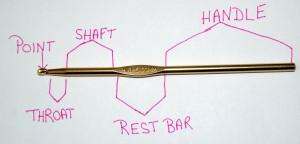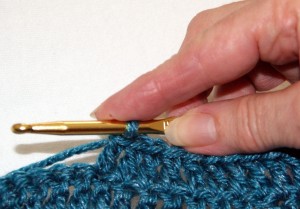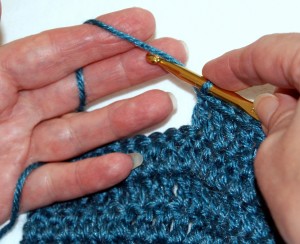The way you hold your crochet hook is a very personal thing. The most important thing to remember is not to grip it so hard that your hand muscles and fingers become exhausted. To me, that takes the fun out of crocheting!! Just a light but secure grip is all that is needed.
I guess first it is helpful to dissect a crochet hook. You have the point, throat, shaft, thumb rest and handle. The shaft and thumb rest is where your fingers will always be when crocheting. The point and throat are where you actually make your stitches and the handle is basically there for balance.
My grandmother originally taught me how to crochet but being the only left-handed person in my family, she could only teach me how to hold the hook like a right-handed crocheter. Actually, I have found that holding and working the crochet hook in my right hand and controlling the yarn with my left hand really is much easier for me because the hook movement is just a repetitive motion but keeping the tension and working with the yarn requires more control. Using my left hand for the more intricate work (which is my stronger and more coordinated hand) works great for me!!
You will probably crochet using either a Pencil Grip or a Knife Grip. I use the knife grip when I crochet and find it very comfortable and easy for me. With my right hand, I place my thumb on the front of the thumb rest which will be facing me, place my index finger onto the shaft and hold the back of the thumb rest against my middle finger. The handle will just lay against my ring finger and the palm. There is very little movement of my fingers on my right hand when I crochet. I slightly move my index finger along the shaft to help hold the loops in place as I make my stitches and that is it.
Now my left hand does a lot more work for me. I personally like to wrap the yarn around several fingers to get good tension on the yarn. I will place the yarn under my pinky finger, over my ring finger, under my middle finger and over my index finger. My crochet piece will be held in place using my middle finger and thumb with my ring finger and pinky helping to hold ever so slightly. My index finger on my left hand does all the work. I yarn over onto the hook with my left index finger, push the point of the crochet hook through the proper loops using my right hand and bracing with my left middle finger, guiding with my left thumb, and using my left ring finger and pinky as support. I have great success crocheting in this manner. I don’t know if this is the motion a true right-handed crocheter uses but I have found this a very workable method for me and I am a very left-handed individual. I even use my left foot to push the pedal on my sewing machine!!
Keep practicing and work on what is really comfortable for you when crocheting. Hopefully, this will give you some guidelines whether you are right or left-handed for holding your hook and work. I know there are some good directions for left-handed crocheting if this method doesn’t work for you. Give it a try, you might like it!!
- TIP: If you are really a beginner or if you are trying to teach a youngster how to crochet, I would suggest that you only wrap the yarn over your left index finger as your tension guide until you get the feel of both hands and yarn working together. After you feel comfortable with practice, then proceed to weave the yarn around the additional fingers on your left hand.
HAPPY CREATING!!
Disclaimer: This post contains affiliate links – “small commission earned”




